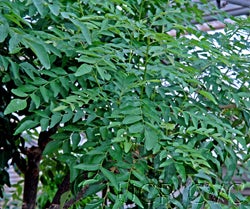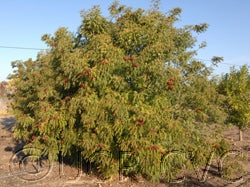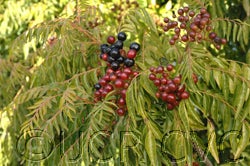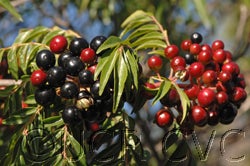Curry leaf
CRC 3165
PI 539745
Source
Received as seed from Bill Stewart, Arboretum, Pasadena, CA, date unknown.
Parentage/origins
Parents unknown.
Rootstocks of accession
own roots
Season of ripeness at Riverside
July to May
Season of flowering at Riverside
May to October
Description from The Citrus Industry Vol. 1 (1967)
"Kurz (1877, vol. 1, p. 190) described this species as follows: "An evergreen tree, 15-20 ft. [4.6-6.1 m] high, trunk 4-10 ft. [1.2-3 m] high, 1/2-1 1/2 ft. [15-46 cm] in circum., glabrous or slightly puberulous; leaves unpaired-pinnate, the rachis usually more or less pubescent, rarely quite glabrous; leaflets in 5-10 pairs with an odd one, on a short puberulous petiolule, oblong-lanceolate or ovate, almost falcate, oblique at base, about 1-1 1/2 in. [2.5-3.8 cm] long, acuminate, more or less serrulate, membranous, glabrous, except on the midrib, which is often puberulous; flowers small, white, in terminal corymbs; petals oblong-lanceolate, acute, about 2-3 lin. [4-6 mm] long; stamens 10, alternately shorter; ovary 2-celled, the style short and thick; berries oblong, somewhat acute, the size of a small pea, l-2-seeded, bluish-black."
This species was said by Trimen (1893, vol. 1, p. 219) to be "extremely like the small-leaved form of Micromelum pubescens [= M. ceylanicum], from which it may be distinguished by its more numerous more pubescent and small leaflets, and more compact corymbose terminal inflorescence." The pistil is much shorter than the stamens.
Dr. David Fairchild reported (Bur. Pl. Ind., Inventory 88, No. 68351) that "the fresh leaves form a constant ingredient of the Ceylonese curries and give them a very agreeable flavor." He stated further (1930, p. 284) that the fresh leaves of this species are "deemed essential to all the curries of Ceylon." They are "boiled with the curry but thrown out of it before serving." Dr. Fairchild had a fine fruiting tree of M. koenigii growing in his tropical garden, "The Kampong," at Coconut Grove, Florida, where it was one of the most prized of his collection of citrus fruits and their wild relatives). He regularly used the fresh leaves in making curry.
Trimen stated (1893, vol. 1, p. 221): "This is the familiar 'curry-leaf,' a constant ingredient in curries and mulligatawny." He reported the species as rather rare in the wild state in Ceylon but "very much cultivated," doubtless for use in curries.
Dr. David Fairchild obtained seeds of this species in 1926 in Ceylon. Plants grown from this seed have thrived on the peculiar soil (a very sandy loam intermixed with porous limestone fragments of rock that often occupy half or more of the bulk of the soil) found in Miami and vicinity in the extreme southeastern part of Florida."
Availability
Not commercially available in California.
USDA Germplasm Resources Information Network page for Bergera koenigii








